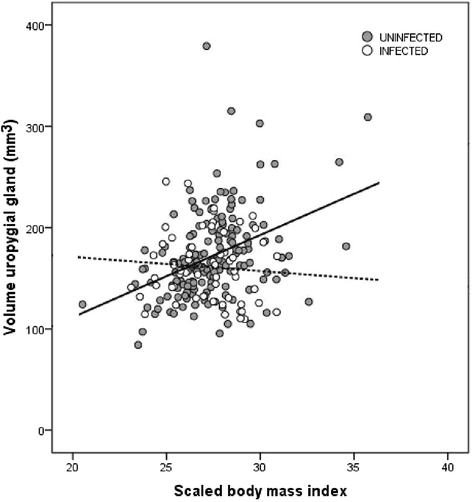Volume and antimicrobial activity of secretions of the uropygial gland are correlated with malaria infection in house sparrows
- PMID: 27114098
- PMCID: PMC4845389
- DOI: 10.1186/s13071-016-1512-7
Volume and antimicrobial activity of secretions of the uropygial gland are correlated with malaria infection in house sparrows
Abstract
Background: Animals have developed a wide range of defensive mechanisms against parasites to reduce the likelihood of infection and its negative fitness costs. The uropygial gland is an exocrine gland that produces antimicrobial and antifungal secretions with properties used as a defensive barrier on skin and plumage. This secretion has been proposed to affect the interaction between avian hosts and their ectoparasites. Because uropygial secretions may constitute a defense mechanism against ectoparasites, this may result in a reduction in prevalence of blood parasites that are transmitted by ectoparasitic vectors. Furthermore, other studies pointed out that vectors could be attracted by uropygial secretions and hence increase the probability of becoming infected. Here we explored the relationship between uropygial gland size, antimicrobial activity of uropygial secretions and malaria infection in house sparrows Passer domesticus.
Methods: A nested-PCR was used to identify blood parasites infection. Flow cytometry detecting absolute cell counting assessed antimicrobial activity of the uropygial gland secretion
Results: Uninfected house sparrows had larger uropygial glands and higher antimicrobial activity in uropygial secretions than infected individuals. We found a positive association between uropygial gland size and scaled body mass index, but only in uninfected sparrows. Female house sparrows had larger uropygial glands and higher antimicrobial activity of gland secretions than males.
Conclusion: These findings suggest that uropygial gland secretions may play an important role as a defensive mechanism against malaria infection.
Keywords: Antimicrobial activity; Flow cytometry; Haemosporidian parasites; Passer domesticus; Preen gland.
Figures
Similar articles
-
Stimuli Followed by Avian Malaria Vectors in Host-Seeking Behaviour.Biology (Basel). 2022 May 9;11(5):726. doi: 10.3390/biology11050726. Biology (Basel). 2022. PMID: 35625454 Free PMC article. Review.
-
Exploring the adjustment to parasite pressure hypothesis: differences in uropygial gland volume and haemosporidian infection in palearctic and neotropical birds.Curr Zool. 2021 Apr;67(2):147-156. doi: 10.1093/cz/zoaa037. Epub 2020 Jul 16. Curr Zool. 2021. PMID: 33854532 Free PMC article.
-
Mosquitoes are attracted by the odour of Plasmodium-infected birds.Int J Parasitol. 2020 Jul;50(8):569-575. doi: 10.1016/j.ijpara.2020.03.013. Epub 2020 Jun 5. Int J Parasitol. 2020. PMID: 32505648
-
House sparrow uropygial gland secretions do not attract ornithophilic nor mammophilic mosquitoes.Med Vet Entomol. 2020 Jun;34(2):225-228. doi: 10.1111/mve.12401. Epub 2019 Aug 14. Med Vet Entomol. 2020. PMID: 31414514
-
Preen oil and bird fitness: a critical review of the evidence.Biol Rev Camb Philos Soc. 2017 Nov;92(4):2131-2143. doi: 10.1111/brv.12324. Epub 2017 Feb 23. Biol Rev Camb Philos Soc. 2017. PMID: 28231637 Review.
Cited by
-
Microbially Mediated Chemical Ecology of Animals: A Review of Its Role in Conspecific Communication, Parasitism and Predation.Biology (Basel). 2021 Mar 27;10(4):274. doi: 10.3390/biology10040274. Biology (Basel). 2021. PMID: 33801728 Free PMC article. Review.
-
Stimuli Followed by Avian Malaria Vectors in Host-Seeking Behaviour.Biology (Basel). 2022 May 9;11(5):726. doi: 10.3390/biology11050726. Biology (Basel). 2022. PMID: 35625454 Free PMC article. Review.
-
Great Tit (Parus major) Uropygial Gland Microbiomes and Their Potential Defensive Roles.Front Microbiol. 2020 Jul 28;11:1735. doi: 10.3389/fmicb.2020.01735. eCollection 2020. Front Microbiol. 2020. PMID: 32849371 Free PMC article.
-
Biosafe Management of Botrytis Grey Mold of Strawberry Fruit by Novel Bioagents.Plants (Basel). 2021 Dec 12;10(12):2737. doi: 10.3390/plants10122737. Plants (Basel). 2021. PMID: 34961208 Free PMC article.
-
Exploring the adjustment to parasite pressure hypothesis: differences in uropygial gland volume and haemosporidian infection in palearctic and neotropical birds.Curr Zool. 2021 Apr;67(2):147-156. doi: 10.1093/cz/zoaa037. Epub 2020 Jul 16. Curr Zool. 2021. PMID: 33854532 Free PMC article.
References
-
- Poulin R, Morand S. Parasite biodiversity. Washington DC: Smithsonian Institution Books; 2004.
Publication types
MeSH terms
Substances
LinkOut - more resources
Full Text Sources
Other Literature Sources


